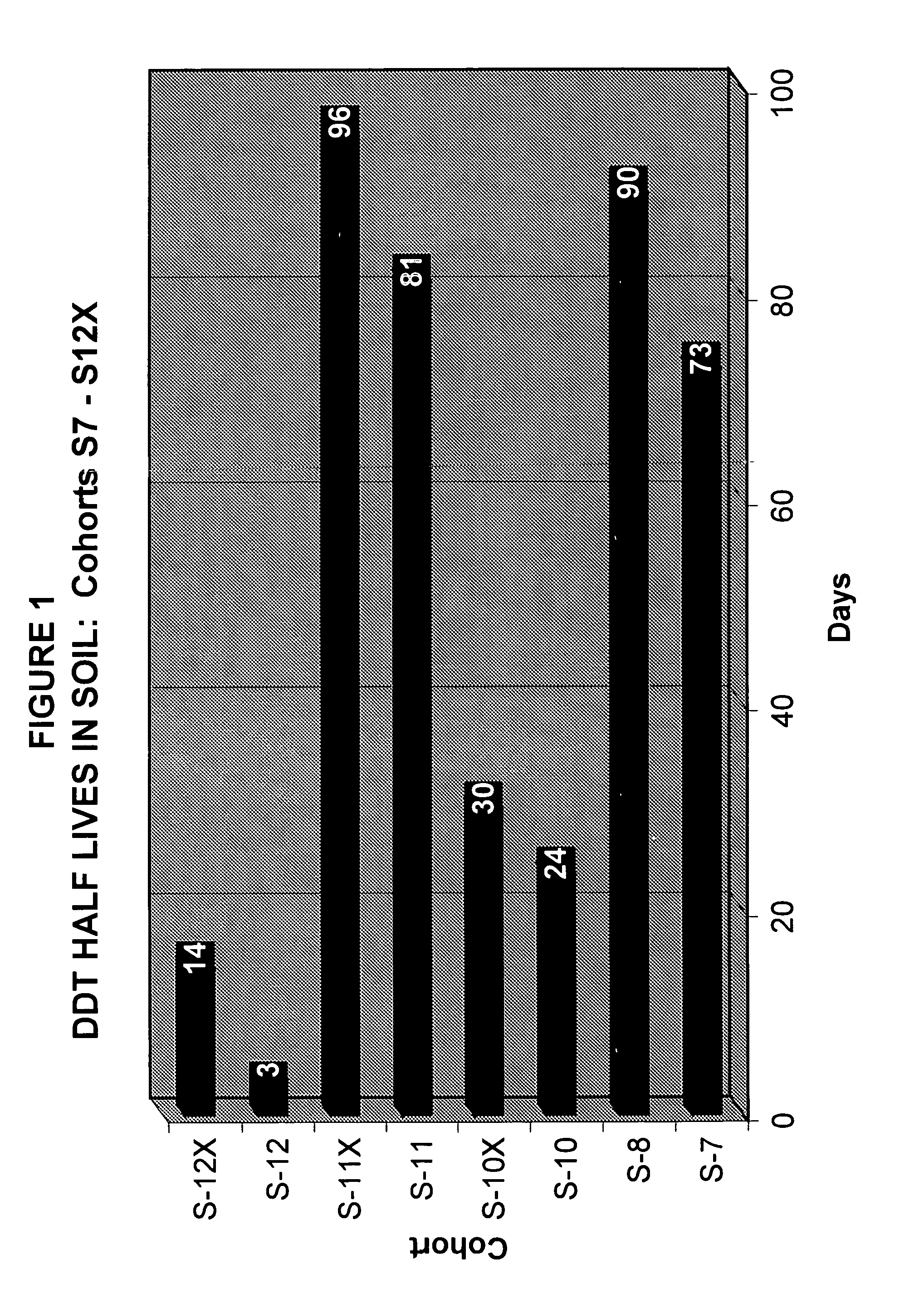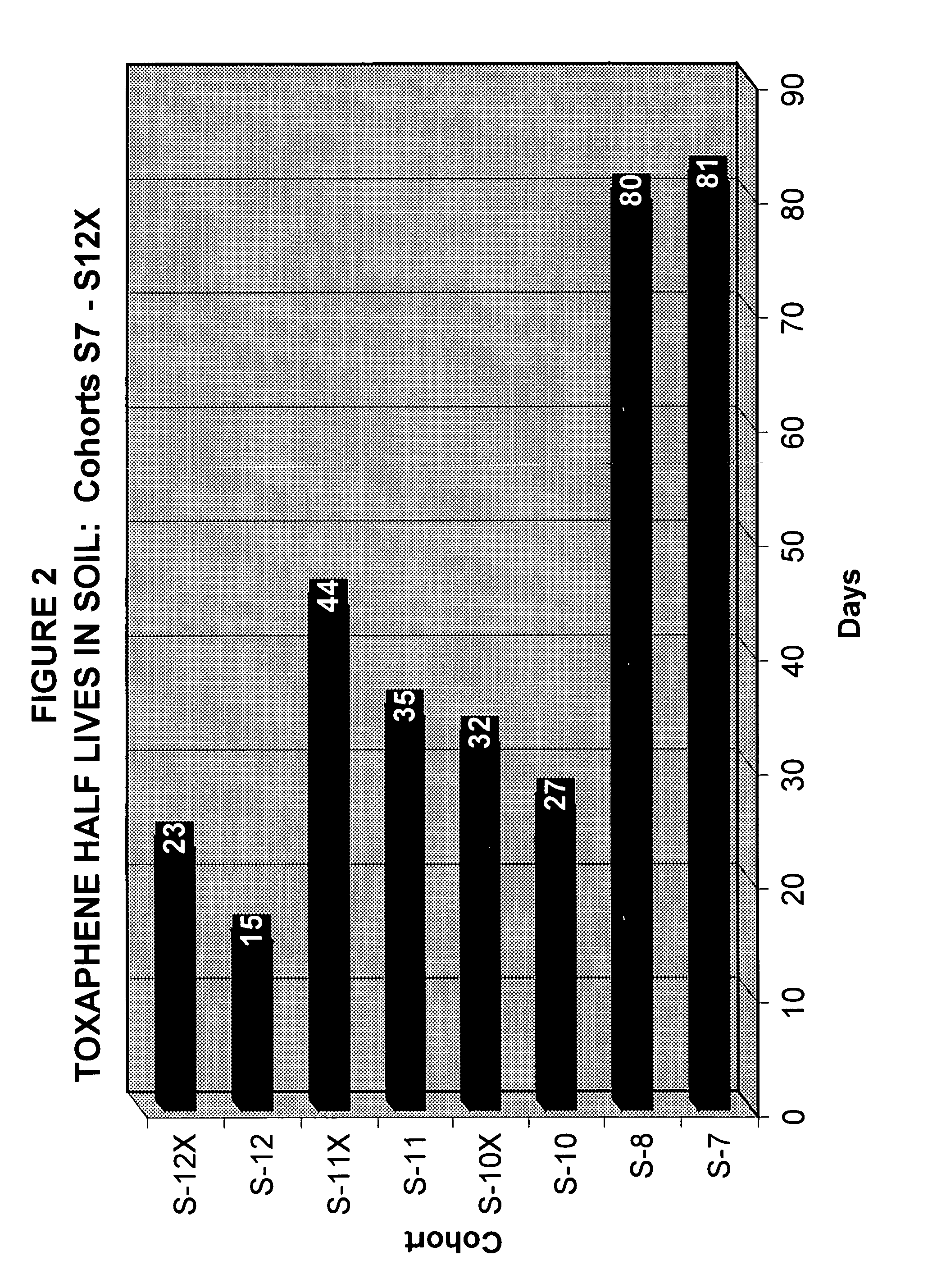Plant-fiber containing composition for anaerobic bioremediation
a technology of anaerobic bioremediation and plant fiber, which is applied in the direction of biochemical water/sewage treatment, enzymology, microorganisms, etc., can solve the problems of substantial, long-term hazard to human health and the environment, and the release of chemical contaminants into the environment, so as to enhance the activity of such microorganisms, enhance the ability of these materials, and enhance the effect of physical extraction, absorption and adsorption of hydro
- Summary
- Abstract
- Description
- Claims
- Application Information
AI Technical Summary
Benefits of technology
Problems solved by technology
Method used
Image
Examples
example 1
[0049]Prior to the development of the present invention, a pilot-scale test of four different approaches to the anaerobic bioremediation of the recalcitrant, hydrophobic organochlorine pesticides DDT and toxaphene was conducted from April 1996 though April 1997 in order to investigate the combination of different approaches to the implementation of denitrification-based bioremediation and phytoremediation. One trial, initiated in February 1997 and completed in April 1997, involved the use of an embodiment of a previously disclosed “denitrification-based bioremediation” liquid-chemical composition (Hince et al., pending patent application Ser. No. 08 / 862,782), for which several claims have been approved at the time of this filing for the present invention disclosed herein. Among other inventions, Hince et al. disclose several liquid-chemical compositions for promoting anaerobic biodegradation of toxic organic and inorganic compounds under anaerobic conditions including denitrifying, ...
example 2
[0053]An investigation was undertaken in the late fall of 1999 to identify the types of bacteria present in uncontaminated, pesticide contaminated (but untreated) and post-treated soils associated with the pilot studies described in EXAMPLE 1. Soil samples representative of these conditions were analyzed using denaturing gradient gel electrophoresis (DGGE) methods to separate and sequence the 16S rDNA genes of the bacteria present. The results of the DGGE 16S rDNA analyses were compared to an international computer database for bacterial DNA. The resultant DGGE “gels” revealed that novel Fibrobacter spp. dominated the microbial community present in the post-treated sample, whereas such species were significantly less abundant in the DGGE gels for the contaminated-but-untreated sample and the “clean” sample. The results also indicated that other novel and / or previously unexpected “adapted” populations of soil and / or legume-related bacteria such as Rhizobium spp. and Bradyrhizobium sp...
example 3
[0055]Several additional sets of bench-scale, microcosm experiments were conducted in the laboratory to investigate the effectiveness of using different embodiments of the primarily organic solid-chemical composition of the present invention disclosed herein alone or in combination with either a previously disclosed liquid-chemical composition (Hince et al., pending patent application Ser. No. 08 / 862,782), a novel liquid-chemical composition and / or a geochemical (i.e., inorganic) solid-chemical composition.
[0056]As shown in FIGS. 1 and 2, experimental cohorts S-7 and S-8, which were only treated with an inorganic solid-chemical composition or a liquid-chemical composition previously disclosed by Hince et al. (pending patent application Ser. No. 08 / 862,782) demonstrated pesticide biodegradation half-lives on the order of a minimum of three months. Cohorts S-10X, S-11X and S-12X, which were treated with a simplified embodiment of the primarily organic solid-chemical composition disclo...
PUM
 Login to View More
Login to View More Abstract
Description
Claims
Application Information
 Login to View More
Login to View More - R&D
- Intellectual Property
- Life Sciences
- Materials
- Tech Scout
- Unparalleled Data Quality
- Higher Quality Content
- 60% Fewer Hallucinations
Browse by: Latest US Patents, China's latest patents, Technical Efficacy Thesaurus, Application Domain, Technology Topic, Popular Technical Reports.
© 2025 PatSnap. All rights reserved.Legal|Privacy policy|Modern Slavery Act Transparency Statement|Sitemap|About US| Contact US: help@patsnap.com


